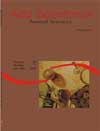Influência das densidades de estocagem e sistemas de aeração sobre o peso e características de carcaça da tilápia do Nilo (<em>Oreochromis niloticus</em> Linnaeus, 1757)
Resumo
O experimento foi conduzido em nove tanques (38m2), durante 252 dias, com Oreochromis niloticus, revertidas para macho, pesando em média 16,3g, alimentadas com ração comercial (29,5% PB). Comparou-se a eficiência dos sistemas de aeração (A1=controle-sem aeração; A2=compressor radial e A3=chafariz), em três densidades de estocagem (D1=3 peixes/m3; D2=6 peixes/m3 e D3=9 peixes/m3), avaliadas através do peso final (PF) dos peixes, peso de carcaça (PC), filé (PFI), pele (PP), gordura visceral (PGV) e rendimentos de carcaça (RC) e filé (RFI). O delineamento foi inteiramente casualizado, em esquema fatorial 3x3, com 30 repetições, sendo o peixe considerado a unidade experimental. O maior PF (530,27g) e PC (431,22) foram obtidos na D1. O compressor radial (A2) foi significativamente mais eficiente do que os demais sistemas, para PF e PC, porém para PFI, somente foi significativamente mais eficiente na D2 (162,67g). O maior PGV (37,36g) e PP (38,13g) foram observados na D1 respectivamente, com A2 e A3. Para RC, não houve diferença entre as densidades e o A3 proporcionou o maior resultado, apesar de não diferir de A1. O RFI variou de 31,73% (A2D1) a 37,14% (A1D1) entre os tratamentos.Downloads
DECLARAÇÃO DE ORIGINALIDADE E DIREITOS AUTORAIS
Declaro que o presente artigo é original, não tendo sido submetido à publicação em qualquer outro periódico nacional ou internacional, quer seja em parte ou em sua totalidade.
Os direitos autorais pertencem exclusivamente aos autores. Os direitos de licenciamento utilizados pelo periódico é a licença Creative Commons Attribution 4.0 (CC BY 4.0): são permitidos o compartilhamento (cópia e distribuição do material em qualqer meio ou formato) e adaptação (remix, transformação e criação de material a partir do conteúdo assim licenciado para quaisquer fins, inclusive comerciais.
Recomenda-se a leitura desse link para maiores informações sobre o tema: fornecimento de créditos e referências de forma correta, entre outros detalhes cruciais para uso adequado do material licenciado.








































